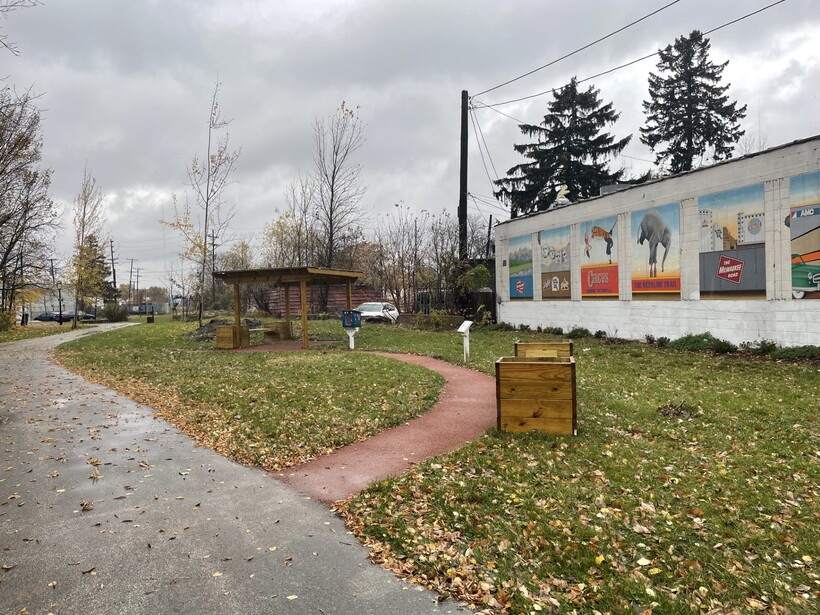Vacant Lots Becoming Public Healing Spaces
City of Milwaukee program has found broad support from neighbors.

A “healing space” in Milwaukee on a once former city-owned vacant lot. Photo courtesy of the City of Milwaukee
For years, Rosalind Cox would watch as people used a vacant lot on Milwaukee’s north side to gather before going into a nearby liquor store.
But after partnering with the city through its “Healing Spaces Initiative,” that city-owned lot was transformed into a space with plants, benches, stones and paths.
People now gather there to read, walk and talk with others.
“It is a healing space and I would say there has been healing going on with the community,” Cox said about the space.
Milwaukee has over 3,200 vacant city-owned lots. Starting in 2021, the city launched the new initiative, largely in response to the isolation many were feeling from the COVID-19 pandemic.
“We thought this would be a great opportunity to bring people back outside, bring them back together and to utilize some of our vacant lot spaces,” said Angela Mitchell Reid, the community outreach liaison for the program.
Mitchell Reid said the goal is to bring relaxing and natural environments to city-owned vacant lots for residents to enjoy. Part of the plan is also to eliminate blighted spaces and to activate those spaces for new uses.
There are currently 14 healing spaces across the city, most of them on the city’s north side and many run by churches, neighborhood groups or community organizations.
“We’re trying to get as many as we can in different spots across the city,” Mitchell Reid said.
Her hope is for the spaces, which vary in size and design, to be used for town hall meetings, yoga sessions, healthy eating workshops, therapy opportunities and other events; all at no cost to residents. Most of them look like a pocket park, with benches, lighting, gardens and plants. Some of them even have bird houses, little free libraries and even chess tables for people to use.
“It’s a way to engage the public and to utilize our vacant spaces,” Mitchell Reid said. “We want people, if they’re utilizing these spaces, to feel calm and relaxed.”
When the city first started the initiative, Mitchell Reid said she heard from residents that they felt valued and appreciated.
“We have a lot of vacant lots and while we don’t have the opportunity to create green spaces on all of them, the ones we have had a chance to utilize have been very important to the residents,” she said.
To apply for a space, residents or community organizations must live in the neighborhood where the lot is located. The city’s department of public works manages basic upkeep, like clearing snow, mowing the lawn and removing litter. But community partners maintain the other amenities.
“Every vacant lot has a story behind it and if we can make it a positive one by installing green spaces or adding a healing space to these vacant lots, I think that’s an important aspect of lot development and also engagement with the community,” Mitchell Reid said.
Two more healing spaces are set to open in 2024.
Cox said the healing space she partners with, near Washington Park, will soon be used as a small music venue. She also wants it to be a space for teaching and for children to play.
“People like to be entertained, and they love to do entertaining, and you don’t see that a lot unless you go to some of these festivals and some of the festivals are like miles and miles and miles away,” Cox said. “When you got something right here in the community, you can go right down the street and do this.”
Cox said she has big plans for the space in the coming years.
“I would hope that it would build up the community even more … where other people would come out and enjoy the area, having different kind of not just meetings out there, but gatherings,” Cox said. “All those things that involve health, mental health, physical health.”
To learn more about how to apply to start a new healing space, you can visit the city’s website.
Editor’s note: For more on Milwaukee’s healing spaces, see Urban Milwaukee’s coverage from July.
Listen to the WPR report here
Milwaukee is transforming vacant city-owned lots into ‘healing spaces’ with gardens, little free libraries was originally published by Wisconsin Public Radio.
If you think stories like this are important, become a member of Urban Milwaukee and help support real, independent journalism. Plus you get some cool added benefits.





















Great idea. People like open spaces.